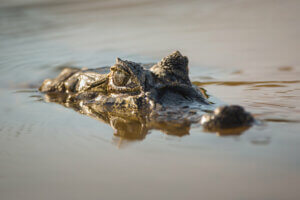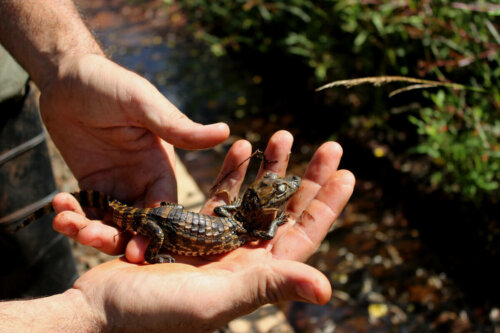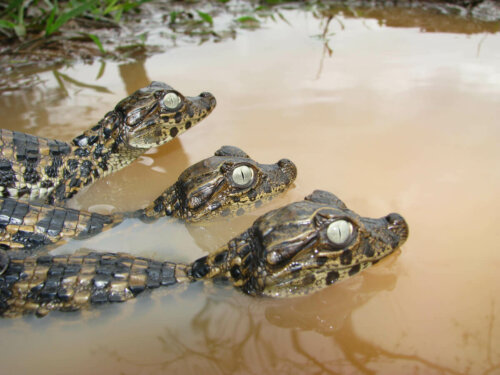The Broad-Snouted Caiman: Threat and Conservation


Written and verified by the vet Érica Terrón González
The Caiman latirostris or broad-snouted caiman is a species of crocodile from the family Alligatoridae. This animal is native to the tropical regions of Latin America and people have been hunting it for many generations.
This is why it’s now a part of the list of protected species of the CITES convention. Note that it’s in Appendix II and this is indicative of the success of their recovery efforts.
Have you ever heard about the threats this animal has to face? And how it came to need efforts for its conservation? We’ll answer these and many other questions in the following lines.
Generalities about the broad-snouted caiman
Here are some of the most characteristic aspects of this fascinating animal species.
Exterior appearance and morphology
Firstly, a broad-snouted caiman can exceed 8 feet in length and reach almost 200 pounds in weight. Also, they manifest a marked sexual dimorphism as the females are smaller. As for their differences with other species of caimans, the following stand out:
- The color of their scales is like camouflage with intense green and grayish tones. This allows these animals to blend in with their surroundings
- Their muzzle is robust and short and as wide as the rest of their head
- The size of the protective plates on their necks are larger than in most of their relatives
Juvenile specimens have a characteristic striped pattern that occasionally remains all the way into adulthood.
This alligator has a muscular, laterally sharpened tail, along with a practically waterproof skin. This makes them excellent swimmers and they’re perfectly adapted to dense vegetation. In addition, their eyes and nostrils are on the back of their head and, thanks to this, they can hide in the undergrowth and remain unnoticed.

Habitat of the broad-snouted caiman
This species inhabits all types of swamps and lakes in South America. It’s mainly distributed in Bolivia, Brazil, Argentina, Paraguay, and Uruguay, in the basins of rivers such as the Amazon.
The broad-snouted caiman prefers dense vegetation and a warm, humid climate. It facilitates hunting, reproduction, and subsequent breeding and this is because the presence of competitors is limited in these ecosystems. Despite this, it can also survive in more temperate, dry climates.
Unlike other relatives, the broad-snouted caiman isn’t easy to watch in the large clean watercourses. They prefer shallow, vegetated aquatic environments. It’s because these places have many resources and predators have a hard time going in there.
Feeding habits
Like the other components of the Alligatoridae family, this caiman’s diet is exclusively carnivorous. They mainly eat mollusks and crustaceans found in the lands surrounding the waterway.
Even so, this animal also ingests other reptiles and small mammals. Thus, it isn’t a particularly harmful or dangerous hunter — from a predatory perspective.
Why is the broad-snouted caiman a threatened species?
First of all, juvenile broad-snouted caimans have a high mortality rate in the wild. Their main predators are the birds of prey that fly over their territory but also herons, storks, foxes, and all kinds of carnivores that inhabit the wetlands. However, humans are responsible for this species being on the verge of extinction.
The hunting of the broad-snouted caiman exploits their skin for leather goods. It seems this material is more delicate, and less leathery than that of other crocodile species. Hunters are also after their meat and eggs, although this is on a smaller scale.
Alarms were raised and numerous conservation projects launched for this species in their countries of origin for all the above reasons. Thanks to them – and to CITES protection – the broad-snouted caiman is now classified as a species “of minor concern.”
Interest in conserving the broad-snouted caiman
Several countries developed broad-snouted caiman farms in order to supposedly achieve a “responsible and sustainable” use of this species. This is the case in Brazil and Argentina, for example. These farms raise and release a percentage of the animals they breed in order to repopulate the natural habitats that are badly affected by hunting practices.
The rest of the animals are kept on the farm to cover the market demand, as they would do with any other commercially exploited species. This way, solving the human “needs” can reduce the traffic of individuals and excessive furtive hunting.
It’s worth mentioning that conservationists encountered some difficulties with their captive breeding. Firstly, breeding in farms wasn’t useful since the mortality of most youngsters released was 90%.
It was for this reason that they implemented the “ranching” technique. This consists of harvesting wild eggs to incubate them and raising them artificially during the first winter. This is because it’s the only way to increase the survival rate to 92%.

Conserving a species to save an ecosystem
In reality, the preservation of this species has had a positive impact. The success of breeding the broad-snouted caiman in captivity and then returning them to the wilderness has stimulated interest in the conservation of the wetlands where they live and it discourages environmental malpractice.
As you can see, the protection of a species translated into the conservation of their entire ecosystem, with all that this implies. The history of broad-snouted caiman is a lesson for human beings and we can save species from extinction with the right means and proper efforts.
The Caiman latirostris or broad-snouted caiman is a species of crocodile from the family Alligatoridae. This animal is native to the tropical regions of Latin America and people have been hunting it for many generations.
This is why it’s now a part of the list of protected species of the CITES convention. Note that it’s in Appendix II and this is indicative of the success of their recovery efforts.
Have you ever heard about the threats this animal has to face? And how it came to need efforts for its conservation? We’ll answer these and many other questions in the following lines.
Generalities about the broad-snouted caiman
Here are some of the most characteristic aspects of this fascinating animal species.
Exterior appearance and morphology
Firstly, a broad-snouted caiman can exceed 8 feet in length and reach almost 200 pounds in weight. Also, they manifest a marked sexual dimorphism as the females are smaller. As for their differences with other species of caimans, the following stand out:
- The color of their scales is like camouflage with intense green and grayish tones. This allows these animals to blend in with their surroundings
- Their muzzle is robust and short and as wide as the rest of their head
- The size of the protective plates on their necks are larger than in most of their relatives
Juvenile specimens have a characteristic striped pattern that occasionally remains all the way into adulthood.
This alligator has a muscular, laterally sharpened tail, along with a practically waterproof skin. This makes them excellent swimmers and they’re perfectly adapted to dense vegetation. In addition, their eyes and nostrils are on the back of their head and, thanks to this, they can hide in the undergrowth and remain unnoticed.

Habitat of the broad-snouted caiman
This species inhabits all types of swamps and lakes in South America. It’s mainly distributed in Bolivia, Brazil, Argentina, Paraguay, and Uruguay, in the basins of rivers such as the Amazon.
The broad-snouted caiman prefers dense vegetation and a warm, humid climate. It facilitates hunting, reproduction, and subsequent breeding and this is because the presence of competitors is limited in these ecosystems. Despite this, it can also survive in more temperate, dry climates.
Unlike other relatives, the broad-snouted caiman isn’t easy to watch in the large clean watercourses. They prefer shallow, vegetated aquatic environments. It’s because these places have many resources and predators have a hard time going in there.
Feeding habits
Like the other components of the Alligatoridae family, this caiman’s diet is exclusively carnivorous. They mainly eat mollusks and crustaceans found in the lands surrounding the waterway.
Even so, this animal also ingests other reptiles and small mammals. Thus, it isn’t a particularly harmful or dangerous hunter — from a predatory perspective.
Why is the broad-snouted caiman a threatened species?
First of all, juvenile broad-snouted caimans have a high mortality rate in the wild. Their main predators are the birds of prey that fly over their territory but also herons, storks, foxes, and all kinds of carnivores that inhabit the wetlands. However, humans are responsible for this species being on the verge of extinction.
The hunting of the broad-snouted caiman exploits their skin for leather goods. It seems this material is more delicate, and less leathery than that of other crocodile species. Hunters are also after their meat and eggs, although this is on a smaller scale.
Alarms were raised and numerous conservation projects launched for this species in their countries of origin for all the above reasons. Thanks to them – and to CITES protection – the broad-snouted caiman is now classified as a species “of minor concern.”
Interest in conserving the broad-snouted caiman
Several countries developed broad-snouted caiman farms in order to supposedly achieve a “responsible and sustainable” use of this species. This is the case in Brazil and Argentina, for example. These farms raise and release a percentage of the animals they breed in order to repopulate the natural habitats that are badly affected by hunting practices.
The rest of the animals are kept on the farm to cover the market demand, as they would do with any other commercially exploited species. This way, solving the human “needs” can reduce the traffic of individuals and excessive furtive hunting.
It’s worth mentioning that conservationists encountered some difficulties with their captive breeding. Firstly, breeding in farms wasn’t useful since the mortality of most youngsters released was 90%.
It was for this reason that they implemented the “ranching” technique. This consists of harvesting wild eggs to incubate them and raising them artificially during the first winter. This is because it’s the only way to increase the survival rate to 92%.

Conserving a species to save an ecosystem
In reality, the preservation of this species has had a positive impact. The success of breeding the broad-snouted caiman in captivity and then returning them to the wilderness has stimulated interest in the conservation of the wetlands where they live and it discourages environmental malpractice.
As you can see, the protection of a species translated into the conservation of their entire ecosystem, with all that this implies. The history of broad-snouted caiman is a lesson for human beings and we can save species from extinction with the right means and proper efforts.
All cited sources were thoroughly reviewed by our team to ensure their quality, reliability, currency, and validity. The bibliography of this article was considered reliable and of academic or scientific accuracy.
- Caiman latirostris [Internet]. Es.wikipedia.org. [cited 8 September 2020]. Available from: https://es.wikipedia.org/wiki/Caiman_latirostris
- El yacaré overo [Internet]. 2002 [cited 8 September 2020]. Available from: http://produccion-animal.com.ar/produccion_yacares/05-yacare_overo.pdf
- Graña Velasco G. Interés por la producción de yacarés [Internet]. El Campo Regional Centro, Buenos Aires; 2005 [cited 8 September 2020]. Available from: http://produccion-animal.com.ar/produccion_yacares/01-interes_yacares.pdf
- Perran Ross J. International Workshop for Management and Trade of Caiman yacare [Internet]. Gainesville, Florida, USA; 2003 [cited 8 September 2020]. Available from: https://portals.iucn.org/library/sites/library/files/documents/2003-027.pdf
This text is provided for informational purposes only and does not replace consultation with a professional. If in doubt, consult your specialist.








